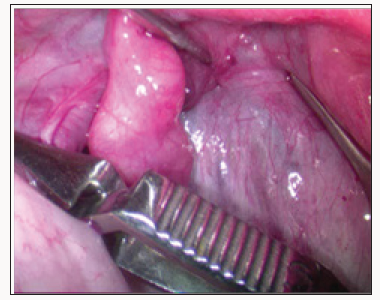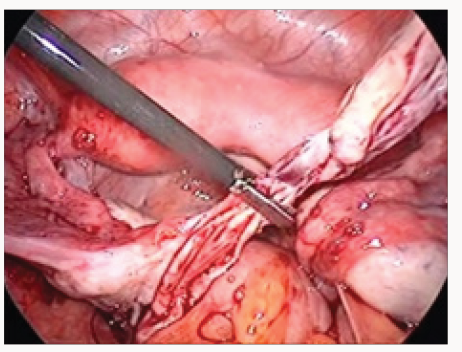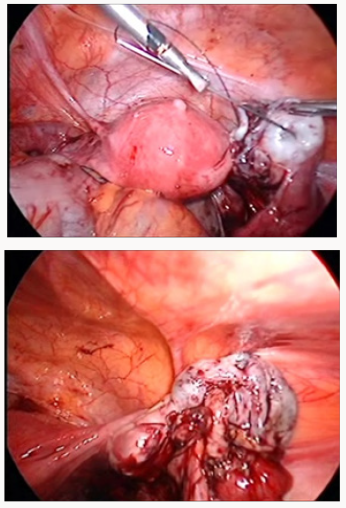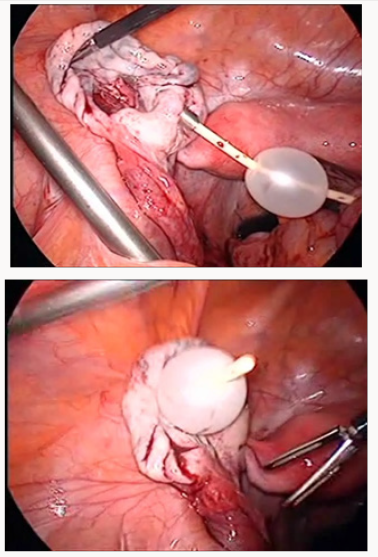Lupine Publishers | Journal of Health Research and Reviews
Currently, surgical treatment of the ovaries is carried out
mainly by laparoscopic entry. Surgical interventions are always
associated with the need for hemostasis. All types of energy that
are used in surgery (mechanical, electrical, thermal, welding,
laser, etc.), depending on various pathophysiological mechanisms,
affect the ovarian tissue and damage the ovarian reserve in
women of reproductive age [1,2]. The ovarian suture causes an
intense inflammatory reaction to the foreign body (tissue necrosis,
granulation tissue) even around the suture material that dissolves
within 30-60 days. In surgery, conservative hemostasis methods
involving temporary compression are widely used: hemostasis
during acute gastroduodenal ulcer bleeding, liver damage.Thus, temporary compression hemostasis can be suggested as an alternative to thermal and ultrasound methods and as the one that causes minimal damage to the ovarian reserve. Furthermore, phylogenetically the ovary “got used” to permanent monthly hemorrhages, hematomas and ischemia during ovulation. Taking into account the peculiarities of ovarian blood supply, as well as natural monthly traumatization of the ovaries accompanied by the formation of hematomas in the area of an ovulation stigma, it was decided to use temporary compression of the ovarian tissue to achieve hemostasis [3,4]. Tactics of the removal of endometrioid and dermoid ovarian cysts includes the following sequential steps:
a. Placement of the vascular bulldog clamps on lig infundibulopelvicum and lig. ovarii proprium (Figure 1).
b. Introduction of several drops of the vasopressor (adrenaline, vasopressin) into the mesosalpinx and mesovarium [5].
c. Removal of the cyst capsule from the ovarian tissue (with minimal capillary hemorrhage and without coagulation) (Figure 2).
d. Ovarian suture and tethering of the ovary to the abdominal wall by straight needle with the monofilament thread (ventrosuspension) (Figure 3).
e. Removal of the vascular bulldog clamps.
f. Assessment of hemostasis and chromohydrotubation.
During surgical treatment of the ovaries affected by thin-walled structures (follicular cysts, corpus luteal cysts, simple serous cystadenomas), stitching of the thinned ovarian tissue with the monofilament thread may appear ineffective. The thread cuts through. Therefore, it is advisable to use the Foley catheter No. 6 or No. 8 for temporary ovarian ventrosuspension. A soft inflated rubber balloon effectively presses the ovary to the abdominal wall (Figure 4).
g. 6-8 hours after the operation (stabilization of clots resulting from natural hemostasis in the ovary) the slippery filament or Foley catheter was easily removed.
h. Ultrasonic monitoring of the ovarian migration after temporary ventro suspension to its usual site of localization (in such a short period the ovary does not manage to fix itself to the peritoneum at the point of its temporary location) [6,7].
112 operations on the ovary were performed with the application of this method: 65 - with fixation by the filament and 47 - with fixation by the Foley catheter. Prior to surgery and in the postoperative period, the main indicators characterizing the state of the ovarian reserve (AMH, FSH, LH, InB), the number of antral follicles and blood flow parameters were controlled. Patient monitoring continues. Long-term results are being analyzed. As a result, temporary compression hemostasis allows.com to perform almost bloodless surgical intervention on the ovary without the use of aggressive coagulation and other physical (laser, ultrasound) effects on the follicular apparatus of the ovary [8,9].
For more Lupine Publishers Open Access Journals Please visit our website:
http://lupinepublishers.us/
For more Research and Reviews on Healthcare articles Please Click Here:
https://lupinepublishers.com/research-and-reviews-journal/
To Know More About Open Access Publishers Please Click on Lupine Publishers
Follow on Linkedin : https://www.linkedin.com/company/lupinepublishers
Follow on Twitter : https://twitter.com/lupine_online







No comments:
Post a Comment